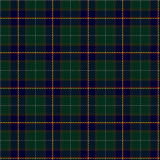Tartan of the 43 Commando (Fleet Protection) Group Royal Marines

When one thinks of Scotland, many iconic images come to mind; rolling green hills, ancient castles, and Nessie swimming in her loch. Even more memorable than these, however, is the patterned fabric which has come to symbolize Scottish culture itself: Tartan is the only textile design in the world of which a tiny scrap can evoke such feelings of pride, such identification with the historical struggles of Scots, and identification with those desirable traits associated with being Scottish - honesty, industriousness and bravery in battle.*
Although tartan-style fabrics have a very long history – a good portion of it not Scottish – today these textiles are most famous as badges of identification. Specific colors and their arrangements function as a symbolic language in their own right, representing individuals, families and clans, as well as professional groups, companies, and organizations. To the huge international family of Scots and their descendants - estimated at 40 to 60 million around the globe - tartan represents everything that is admirable and wholesome about the land of their fathers.*
Dual symbolism of yellow/gold stripe represents a historical link with the Argyll & Sutherland Highlanders. The main association stems from the fall of Dunkirk, when the 5th Battalion served with the Royal Marine Brigade. HMS ‘Prince of Wales’ and ‘Repulse’ were sunk in December 1941. Royal Marines survivors joined with remnants of the 2nd Battalion in the defence of Singapore, forming 'The Plymouth Argyll's', since both ships were Plymouth manned. Annual messages of greetings sent to the Regiment on the anniversary of the Battle of Balaclava are reciprocated on the ‘Corps Birthday.’ A distinctive scarlet and yellow/gold (‘raspberry ripple’) twist replicates the unique Unit lanyard. The remaining subtle colours reflect the understated ethos of Royal Marines, who have consistently operated, as their motto explains, ‘per mare per terram,’ since 28th October 1664. Dark blue square signifies the RM’s dress uniform representing their strong historical links with the Royal Navy. In 1964, an additional ‘Lovat’ semi-formal uniform was introduced, hence the brown/khaki shading reflecting the versatility of RM infantry soldiers. Finally, the dominant shade of green connotes the iconic ‘green beret’ worn by Service personnel who have successfully completed Commando training since 1942.**
*http://www.tartansauthority.com/tartan/
**https://www.tartanregister.gov.uk/tartanDetails?ref=11603
© Symbols.com
